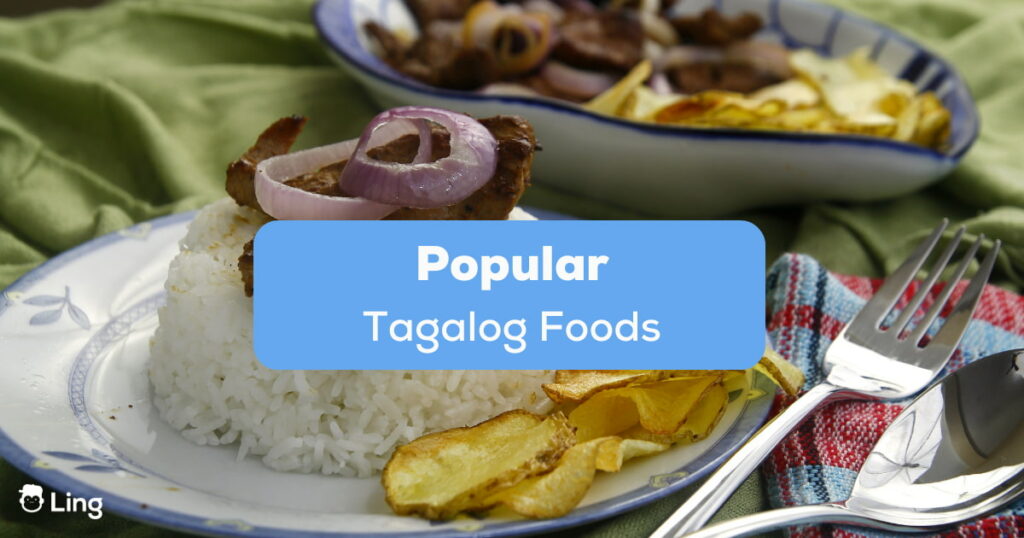Have you had your serving of Adobo yet? Aside from learning the language, another way by which you can understand more about the culture of a country is by awakening your pallet through their cuisine. In today’s article, we will give you a unique tour of some of the most popular Tagalog foods that you must try out!
The Philippines is not just known for its diverse language and specific dialects. It is also the mother of flavourful dishes and savory food fusions that can reflect the country’s rich history. From soy sauce and tofu from China and Japan to fried chicken and hamburgers from America and even Adobo and Paella from Spain, the Philippines can be considered the ultimate melting pot of Asia!
Let’s learn more about Tagalog and the scrumptious and unique popular Tagalog foods you can ever find in this country!
Table of Contents
What Are The Most Popular Tagalog Foods?
Not hungry yet? Of course, aside from the regular Pancit Palabok, Bicol Express, and pan-fried recipes, we have also prepared here some of the hard-to-miss-out popular Filipino cuisine that you have to try when you go to the Philippines.
You see, aside from having boodle fights, you must also have a taste of the best dishes that you can try, along with perfectly steamed rice!
If you’re also keen on ordering some of these popular Tagalog foods, you should try memorizing them on your own. Download the Ling app on the Play Store and the App Store today to pump up your vocabulary and find the right words to fill the void.
As a quick tip, do note that Filipinos love talking about food. In this sense, I suggest that if you want to have a quick conversation with any native, try sharing about your experience with any of these foods, and you will surely make them talk a lot!
I hope that I was able to shed light on the top Filipino food that can certainly awaken your love for the Philippines. If you are in search of a handy language learning buddy for more info about Tagalog foods, you have got to try the Ling app.

What Is The Tagalog Word For Food?
The Tagalog word for food is Pagkain.
Learn more Tagalog vocabulary as we discover Filipino’s favorite meals. You might even find the best one that fits your palate.
What Is Kamayan Food?
Do you know what is even better? A big serving of local food served over freshly cut banana leaves! Traditionally, Filipinos go beyond the word “eating” because they usually make every dining experience special by socializing while devouring a sumptuous meal and by doing the kamayan or the way of eating with your bare hands.
Yep, you read that right! Whether it is to pay cultural respect or for big celebrations, kamayan, also known as Boodle Fight, is a customary way of feasting during family gatherings.
What Are The Favorite Filipino Dishes During Boodle Fight?
Wondering what the common Filipino dishes during kamayan are? We listed here the top Tagalog foods for you to have a clearer picture of some of the best dishes you can expect your Pinoy colleagues to serve you.
As you can see, I added a soup to our list because one of the characteristics of Filipinos is that they usually enjoy having warm and tasty soup dishes to clear the palette once in a while. There are a lot of possible combinations when it comes to making your own kamayan table.
For health-conscious Filipino food eaters, some places also serve additional food essentials such as blanched vegetables like okra (also known as ladies’ fingers in other countries) and kangkong tops (or water morning glory or water spinach).
What Are The Popular Street Foods In The Philippines?
Okay, maybe you think the fancy restaurant is the best food, right? But I tell you, the real Filipino food is on the street! You smell something good, you see all the colors, and it’s like a party already! Let’s go, I’ll show you some amazing snacks.
Eating on the street is not simply about the food. You see people, smell the cooking, it’s exciting! And the prices? They are so cheap that it seems you can try everything!
So don’t be shy! If you see something you don’t know, just point! The vendor will tell you about it. Maybe you will find your new favorite thing.
Come on, are you hungry yet? Filipino street food is waiting! It’s gonna be an adventure, I promise!

What Are The Festive Foods Of The Philippines?
While street food offers exciting flavors, traditional Filipino fiestas showcase a whole other level of culinary delights! There are also specific foods for events like New Year, where Filipinos eat Puto Bumbong or Bibingka. Here are some of the most popular Tagalog dishes that often grace the celebration table:
Did you see that there are tons of Filipino desserts during these events? We enjoy spoiling our sweet tooth! These are just a few of the many delicious Tagalog dishes that make Filipino fiestas so special. Whether you’re lucky enough to attend a fiesta or want to recreate the flavors at home, these dishes are sure to bring joy to your table.
Other Frequently Asked Questions About Popular Tagalog Foods
What Are The Top 10 Filipino Foods?
Below is the list of the top 10 Filipino foods (not in order) of all time:
- Adobo
- Pancit
- Sisig
- Sinigang (Pork, Beef, Seafood)
- Beef Bulalo
- Lechon
- Halo-Halo
- Liempo
- Kare-Kare
- Lumpia
Bonus: Ube desserts! Who can’t get enough of them? Comment your favorite food! Don’t forget to grab your favorite Filipino drinks as well.
What Do Filipinos Eat For Breakfast?
Filipinos love eating Tocino, Pandesal, Tapa, Tuyo, Lugaw, and the famous Silog combination.
These Filipino breakfast meals are usually on the heavier side. Meaning, you’ll have fried rice with garlic and an egg (it can be sunny side up or scrambled) while eating these Filipino dishes. In fact, it has a name of the combination egg plus fried rice: Silog! However, most people also enjoy having light meals like pandesal (lit. salt bread) and a locally-produced jam or filling to go along with it.
Which Are Popular Tagalog Foods Globally?
Foreigners typically enjoy these crowd favorites: Adobo, Sinigang, Bulalo, Ube, Halo-Halo, Lumpia
Filipinos love eating food and are proud to share them with everyone in the world. Have you discovered your favorite food? Do you have a local Filipino restaurant? You should try to order a Tagalog meal right now!
There You Have It!
Filipino food, especially those Tagalog favorites, does more than fill your belly – it fills your heart. Think of boisterous Boodle Fights with friends or the quiet joy of sharing siomai on a bustling street. These dishes bring people together. They spark conversation, laughter, and memories in the making.
So the next time you crave something new and exciting, explore the world of popular Tagalog foods of the Philippines. It’s a delicious adventure, and you might just find flavors that become lifelong favorites.

































































